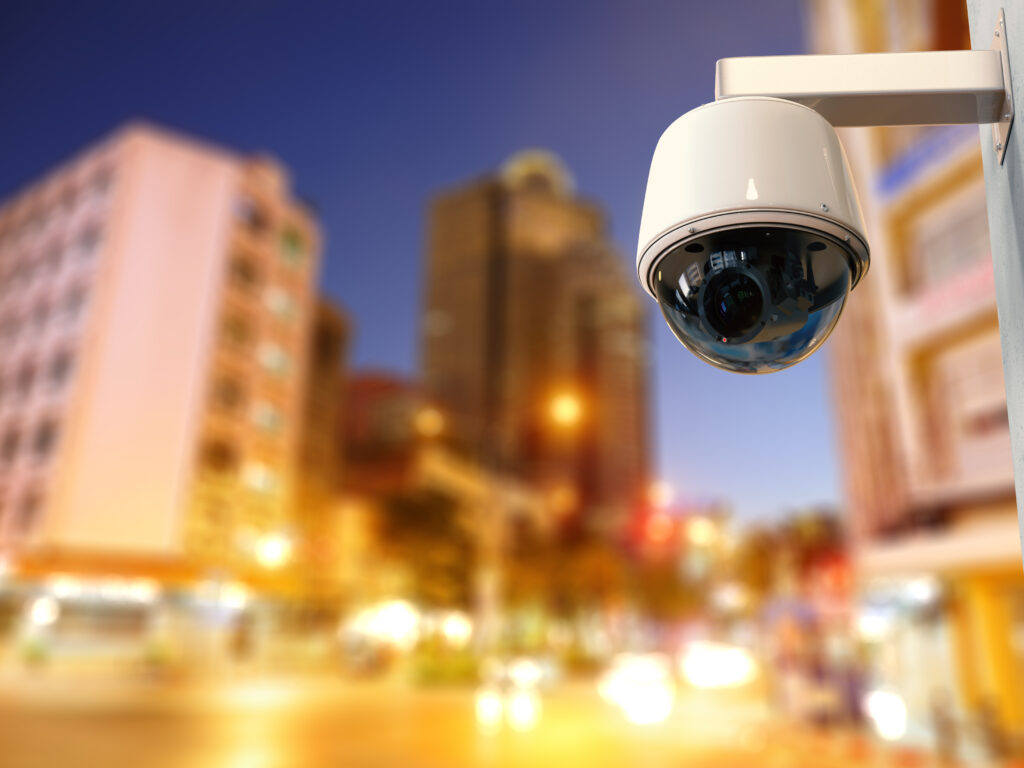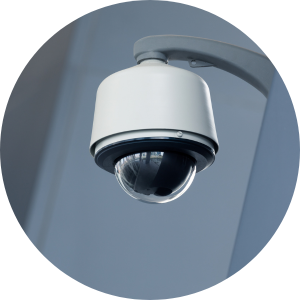
In today’s fast-paced digital world, it’s almost impossible to think of a sector, industry, or business that doesn’t rely on video surveillance to monitor and protect its people, property, and assets.
Video surveillance is a must-have component of any security plan, providing many critical applications and benefits. From security systems to work safety to risk management, video surveillance is used by a broad range of businesses and institutions to improve their operations.
Between 2015 to 2018, the number of installed surveillance cameras grew by nearly 50 percent, from 47 to 70 million, in the United States. But how did this technology go from an ancient concept to a modern necessity?
Early examples of surveillance in ancient civilizations
From the all-seeing eye to the inviolable wall, surveillance has been a part of civilizations from the beginning of time. Early examples of surveillance in ancient cultures have been found worldwide, including the many pyramids in Egypt and Mesopotamia.

In ancient Egyptian civilizations, for example, temple complexes were equipped with strategically placed watchtowers which functioned similarly to today’s monitoring towers or security operations centers (SOCs).
These early forms of surveillance were nothing like today’s modern video surveillance systems, but they did serve a similar purpose of monitoring and protecting people and property.
Industrial Revolution and video surveillance systems
The industrial revolution changed every aspect of society. With the rise of factories, urbanization, and population growth, there was a need for increased security and control in industrialized areas.
Industrial Revolution inventions that laid the groundwork for video surveillance systems included:
Electrical Telegraph (1837): The invention of the electrical telegraph by Samuel Morse enabled the transmission of messages over long distances using electric signals. This laid the groundwork for the future transmission of visual information.
Photography (1839): The invention of photography by Louis Daguerre and William Henry Fox Talbot allowed for the capturing and preserving of images. Photography served as a precursor to video technology, and its advancements contributed to the development of video surveillance.
Electric Light (1879): Thomas Edison’s invention of the practical incandescent light bulb revolutionized lighting and extended the operational hours of surveillance systems, enabling round-the-clock monitoring.
Motion Picture Camera (1891): The creation of the motion picture camera by Thomas Edison and William Kennedy Dickson paved the way for developing video recording technology used in video surveillance.
The increased need for security and control in industrialized areas during this time period eventually led to the four letters every security professional knows, Closed Circuit Television (CCTV).
Early CCTV systems and applications

Video surveillance has come a long way since its inception. In the early days of CCTV systems, the technology was rudimentary and limited in its capabilities. However, these early systems laid the foundation for the advancements we see today.
As with many of today’s technologies, such as GPS, the Internet, and cloud computing, the early days of CCTV systems had their roots in military and government applications.
Early CCTV developments included:
- World War II (1942): German military researchers developed the first CCTV system to monitor bomber runways at night and detect any damage.
- Post World War II (1949): U.S. contractors started developing and selling CCTV systems for use in the commercial and industrial sectors.
- State Security (1960): State security forces and police departments began using CCTV as surveillance strategies. The first police department to use CCTV to monitor public streets occurred in Olean, New York 1968.
In addition to these developments, CCTV systems began to gain popularity in the late 1970s as crime became more prevalent and police departments faced tight budgets. CCTV became a popular choice for communities to prevent crime.
But while these systems provided a valuable tool for law enforcement, they were limited in their abilities and lacked the sophistication of modern systems.
VCR technology advanced CCTV systems
In 1972, security professionals began to look at emerging technologies such as the VCR for potential use in CCTV applications. Although it’s easy to view VCRs as a novelty device of the late 20th century, it was actually a revolutionary piece of technology that helped to open the doors for the future of video surveillance.
With the ability to record and playback video, the security industry began to take notice. In the early 1980s, security manufacturers started to offer CCTV systems for general security applications.
Role of CCTV manufacturers in the evolution of video surveillance
Leading manufacturers of CCTV systems have played a crucial role in the history and evolution of video surveillance. In 1949, Vericon was featured on the cover of Popular Electronics for their ‘intelligent’ CCTV system. Although the system could not record or playback video, it was still marveled for its potential.

Fast-forward to the ’80s and 90’s, when manufacturers such as Hikvision, Dahua Technology and even our current partner Axis Communications, started producing high-quality and innovative CCTV solutions.
For example, Axis Communications, founded in 1984, is widely recognized for introducing the world’s first network camera in 1996. Their products revolutionized the industry by enabling remote access and control of surveillance footage. Other manufacturers quickly followed suit, and the CCTV market boomed with innovative solutions and features such as:
- Multiplexing (1990s)- Although it may sound basic today, multiplexing was a major advancement in video surveillance. It allowed multiple cameras to be controlled by a single recorder and users to view live and recorded footage simultaneously.
- Time-lapse and motion-only recording (1990s)-A basic feature now a staple in most modern systems, time-lapse recording made it possible to record footage at a lower resolution and faster frame rate than the live view.
- IP-based CCTV systems (1990s)-The first centralized IP camera, the AXIS Neteye 200, was released in 1996 by Axis Communications. Although you can probably only find one in a museum today, this camera was a milestone in the history of video surveillance.
- Cloud-based CCTV systems (2010s)-The cloud has changed everything, and video surveillance is no exception! With a cloud-based CCTV system, users can access their surveillance footage anywhere at any time.
Future of Video Surveillance Systems
The history and evolution of video surveillance have paved the way for exciting advancements in the security industry. While privacy and application use remains a concern, new technologies have emerged to help organizations implement and use video surveillance more efficiently.
Modern Video Surveillance Innovations include:
- Artificial Intelligence (AI)-Developed in the 2010s, AI is increasingly being used in video surveillance systems to identify and track people and objects, as well as to detect suspicious activity. This can help organizations to improve their security and safety, and it can also help them to save money by reducing the number of false alarms.
- Deep learning – Deep learning is a type of AI specifically designed to analyze large amounts of data. This makes it ideal for video surveillance systems, as it can identify and track people and objects, even in complex and challenging environments.
- Network video recorders (NVRs) – NVRs are devices that store and manage video footage from CCTV cameras. NVRs are becoming increasingly popular as they offer several advantages over traditional DVRs, including better image quality, greater storage capacity, and easier integration with other systems.
- Video analytics – Video analytics is a software application that analyzes footage from CCTV cameras. Video analytics can be used to identify and track people and objects, as well as to detect suspicious activity. This can help organizations to improve their security and safety, and it can also help them to save money by reducing the number of false alarms.
These are just a few new technologies that have emerged to help organizations implement and use video surveillance more efficiently. As technology advances, we can expect to see even more innovative video surveillance solutions in the future.
Video surveillance integration is crucial for effective security management
The security industry remains at the forefront of video surveillance technology, and as physical security threats and challenges evolve, so will the video surveillance systems deployed to address them.
Regardless of the specific video surveillance application, the most important component is ensuring it integrates with other security systems and supports your overall security management objectives.
To this end, selecting a physical security integrator that offers a comprehensive suite of physical security solutions and has the expertise to design, install, and maintain these systems is critical.
3Sixty Integrated is a proven leader in the integration of video surveillance systems with a successful track record in designing and implementing solutions that address the unique challenges and requirements of clients across a range of industries.
For more information about 3Sixty’s framework and approach to integration, visit https://www.3sixtyintegrated.com/capabilities/ today!
3Sixty Integrated is a Texas-based systems integrator that specializes in the design, installation, and maintenance of physical security technology. We partner with organizations who want to streamline their electronic security infrastructure. Additionally, as a division of The Cook & Boardman Group, 3Sixty Integrated and our sister branches have a nationwide reach and over 65 years of experience offering total opening solutions, from custom doors, frames and hardware to security integration technology. Contact us today to discover how we can help your organization find the most effective security solutions.

